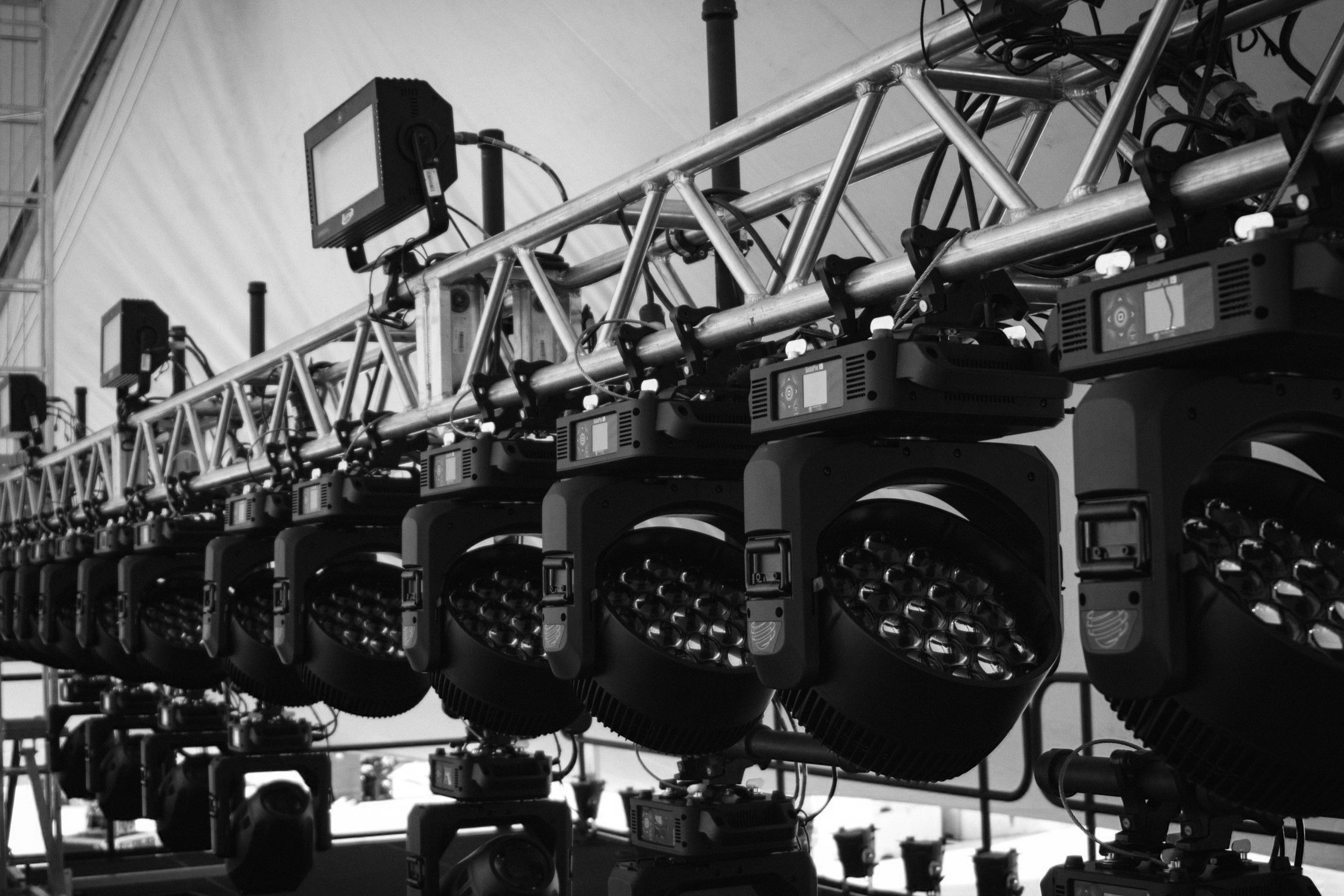
BLog
We want to share our knowledge and help you!
Fog VS Haze: What’s the difference?!
In this blog, we’re talking about the science and technology of atmospheric effects! This is the first blog in a series about atmospheric effects. In this one, we will define haze effects, review how heated atmosphere effects work, and dive a little into the fluids used to make the effect.
Unlocking the Magic of Moving Heads: Types and Features Revealed
In this blog we’re going to explore an essential element of the entertainment industry that sets the tone for any event or performance - Automated Fixtures. Automated, moving head fixtures, or "movers" as they're commonly known, are a type of fixture that create dynamic lighting effects that can transform any space. In this blog, we'll be discussing the different types of moving head fixtures available, their specific functions and purposes, along with the best places to use them. We'll also discuss some of the possible drawbacks and limitations of each fixture.
Basic EQ Techniques for Church Volunteers
In my decades of teaching churches to do audio better, I have heard a pretty good collection of misinformed ideas about how sound works, and nothing seems to attract more bad practices, confusion, and sheer guessing than channel EQ. It’s the most misunderstood part of mixing, and yet it’s one of the most vital components of a good mix. It’s also the hardest part of audio to teach because it relies on developing a critical ear that distinguishes between different frequencies and tonalities and understanding what instruments should sound like. That doesn’t happen in one session or overnight.
The Mystery of Gain Staging
One of the hot topics at this year’s NAMM show was gain staging. Lots of people want to know what it is and why you need to know how to do it. It’s also the root of some of the more common mistakes I see in many churches and schools. It’s not intuitive, but knowing how to do it makes a world of difference in your signal quality. What is gain staging?
Choosing the Right Audio System for Your Event: Key Considerations
Planning a small event, whether it's a birthday party, a corporate meeting, or a band performance, requires careful consideration of many factors to ensure the best audio experience for your audience. One crucial aspect is determining the size of the PA system you'll need. Too large, and you risk overwhelming your space; too small, and your message won't be heard. In this blog, we'll guide you through the steps to help you decide the ideal PA system size for your small event.
How Much Reverb is too Much?
What is reverb? If you’ve ever been in a large room, like a cathedral, you’ve heard naturally occurring reverb. Reverb is short for reverberation, which is a prolonging of a sound. Natural reverb occurs in rooms where the dry/original sound bounces off of surfaces in the room creating a cascade of reflections or echoes of the original that arrive at the listener at different times. The more times the sound bounces around, the more (and different) reflections are created as the energy dies out over time. The sound of the reverb is changed by bouncing off of different materials and surfaces with varying degrees of coarseness and absorption.
Managing Audiences and People
One of the best feelings I’ve experienced is when I’m mixing for a huge event with a ton of people dancing, waving their arms and singing along. A successful event is more than just a bunch of cool gear performing properly, or a well-known band. It’s an event that is well attended, which means large crowds of people packed into the venue…and a whole slew of potential issues to contend with because of them.
Power Requirements
If you’re using a reputable production company for your event, you don’t have to worry about any of those things because they’ve already done all the calculations and have the proper cabling and distribution equipment to make it happen safely. Just don’t be surprised if the power needs are greater than you expected! They’ll likely want to do a site visit to double-check your power and make sure you’re not just counting outlets.
Church Lighting 101
If you were to ask yourself what a church looked like 100+ years ago compared to present time, I am sure most of you would picture a “Little House On The Prairie” type of building that could fit a congregation of no more than 40 people. Church has changed quite radically in the last century; from choirs, pipe organs and stained-glass windows, to filling up concert stadiums with flashing lights and loud music with major production costs. Today we’re going to talk about some basic lighting that can be tailored to fit any budget or stage design.
Why You Should Keep Your Equipment Clean
You just spent thousands on new stage production equipment and anticipate long-lasting uninterrupted service, right? Well, that only happens in a perfect world, and let's face it, we are far from that. However, there are things you can do to minimize your downtime and optimize the life of your equipment. One of the most important, yet overlooked steps you can take is implementing a regular maintenance program. In other words, CLEAN YOUR GEAR!!! When your equipment is hung overhead, tucked in a back closet, or inside of an equipment rack, it’s easy to fall into the “out of sight, out of mind” mentality, but it is crucial for the longevity and reliability of your stage gear to keep it clean.
Do I Need a Line Array for my Event / Venue?
When line arrays started becoming more available a couple of decades ago, it seemed like everyone wanted one. No one really understood how they work, but we all thought it was the latest, greatest technology, so they became very popular. They sounded good and they made touring easier because they could adapt to lots of different seating configurations. But are they appropriate for all venues?
Hiring a Production Company 201
Planning an event can be daunting, especially for those who have never done them before. There are so many details to think through, and if you have no experience with rental houses and production companies, how do you know who you can trust?
Triston did a great job of outlining the basics of production needs and considerations in his blog “Hiring a production company 101” and I’d like to take that a few steps further to help you avoid some of the pitfalls we’ve seen that wreak havoc on events. Asking a few questions can sometimes make the difference between disaster and a successful event.
How Basic Uplighting Can Transform Your Event
Let’s start with the basics: What is uplighting?
For some of you, this may be obvious, and the title itself may be pretty straightforward, but to those who have never used the technique, I’ll give you a textbook definition. Uplighting is when you use lighting from below to illuminate upwards on a surface, or something that might be a point of interest that you want people to see. Most often the fixtures are placed on the ground, but not always.
What Is RDM?
Have you ever been setting up lighting for a concert or event, started programming, and noticed that one of your stagehands or volunteers (or let’s be honest, it was probably YOU who screwed the pooch on this one) has set a DMX address or mode incorrectly on a fixture? Now you have to find a way to get to a light that is now more than likely impossible to access, just to change one small setting that you should have noticed earlier!! Well, let me introduce you to Remote Device Management, otherwise known as RDM.
Networking For Production
In the past few years, production technologies have made a strong move toward IP (Internet Protocol) networks as a transport for audio, video and lighting signals and controls. Audinate’s Dante has emerged as the standard for transmitting audio over standard IP networks, video isn’t far behind, and we’ve been doing remote controls for consoles over wireless networks for years now. Knowing something about networking is essential to keeping up with the progress in today’s connected production systems. Unfortunately, the bits and bytes we use to make networks work are confusing if you have no experience with them. This article is my attempt to get you the basics that you’ll need to navigate an IP connected world.
The Cost of Quality
To get quality results ends up costing more money in the long run when you have to sell off the cheap equipment and purchase better equipment. Not to mention the time and headaches involved in trying to make the cheap stuff work, or dealing with repairs that take forever.
Consider instead, if you buy quality speakers that are properly amplified, tuned, and oriented, use a mixing console with something better than cheap preamps, and buy industry standard microphones that are placed properly, you’re not handicapping your volunteer audio person from the start. In fact, you’ve greatly improved their chances of being successful, and it doesn’t have to be crazy expensive.
Hiring a Production Company 101
Many people are intimidated by the thought of reaching out to a production company. You’ve spent all this time organizing and planning your event, and now it's time to reach out to your local production company. You don’t want to seem like you know nothing, so what information should you have on hand? As a production manager, I see a lot of people following this mentality. I’m here to tell you not to worry, you don’t have to know every little detail! A good production company will be the experts for you, and can help you understand everything needed to make your vision come to life. Hopefully this quick guide will provide you with the knowledge and confidence on what you should have prepared when reaching out.
Gobos:101
Gobos are used with ellipsoidal or spot theatrical fixtures to create lighting scenes on stage. Simple gobos, incorporated into automated lighting systems, are also popular especially at nightclubs and other musical venues to create moving shapes. They may also be used for architectural lighting, as well as in interior design, as in projecting a company logo or message on a wall.
How Loud Should Your Church Service Be?
For the 30+ years that I’ve been mixing live shows and church services there is one thing that remains constant: you can’t please everyone. Inevitably, at nearly every show and service, someone will complain that they can’t hear something or that it’s too loud. It wasn’t because I sucked; I get lots of compliments from musicians who like the way I mix. If someone is going to disagree with what you’re doing in church, I guarantee the #1 request will be to turn it down.
Microphone Selection & Placement - A Quick Reference
One of the most commonly asked questions I get as an audio engineer is regarding what mic to use for a specific application. Unfortunately, there are as many opinions about that question as there are audio techs in the field. There are also about the same number of mics available to choose from. What follows is a compilation of my experience with a variety of mics that are both industry standard and, in most cases, affordable. I’m sure lots of people will want to argue and I’ll hear about all the little nuances and esoteric mics that I missed. Good thing I’m always open to trying new techniques!




















